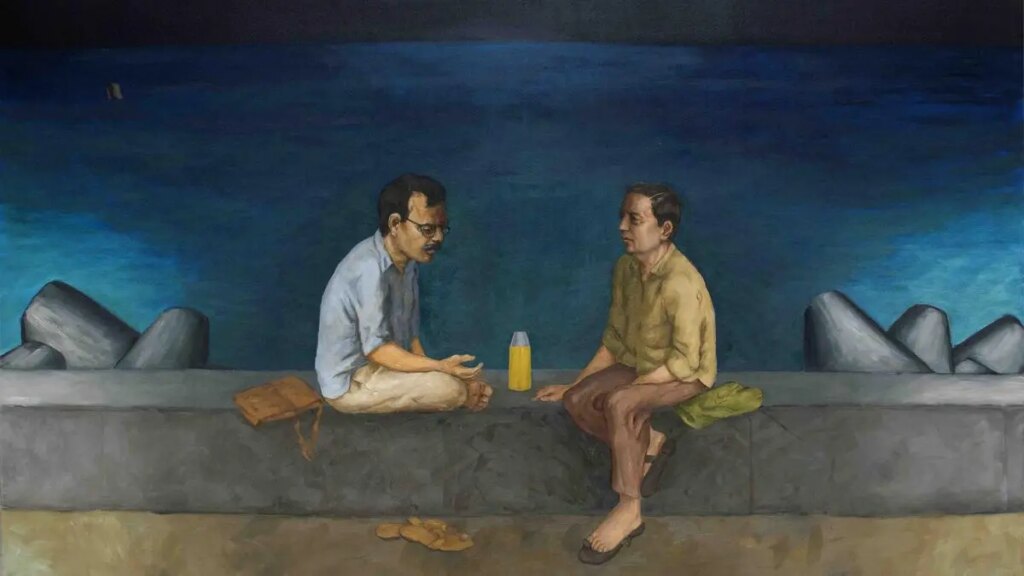The artist, poet, playwright, and physician Gieve Patel (1940–2023) had a special relationship with Mumbai. Born and raised there, he later studied and practised medicine in the city. Mumbai’s streets and people are recurring subjects of his paintings, often invoking the absurdity of the urban landscape, the resilience of its people, and their everyday lives. Patel once said: “Everything I knew about the streets of my city came to my aid. In Bombay, the street is an extension of home, and as we know, it’s sometimes the only home. The emotional range expressed by the crowd was intoxicating, from serene presence to happy camaraderie, to destitution and misery, all in close proximity to each other.”
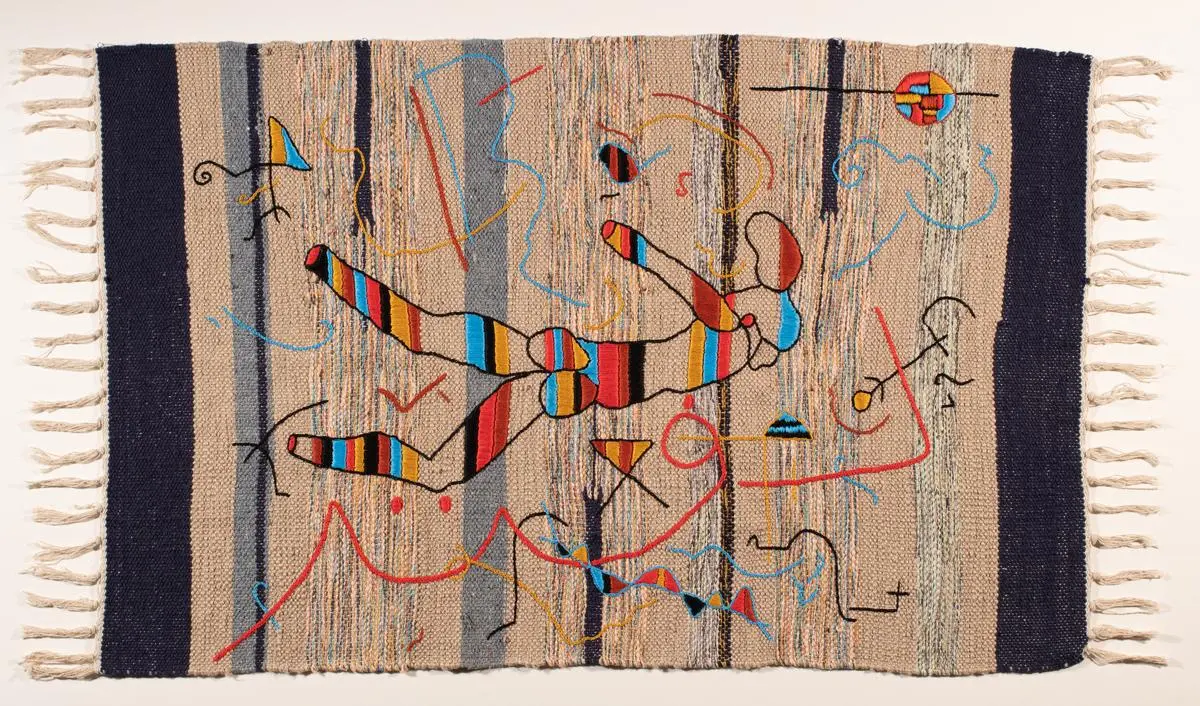
Daphne (after Gieve Patel) by Areez Katki, cotton embroidery on dhurrie rug, 2021.
| Photo Credit:
Gieve Patel and Vadehra Art Gallery
It is apt that the exhibition, “A Show of Hands: In Memoriam” (March 20 to May 25), in memory of Patel, who passed away in 2023, is running at Mumbai’s Jehangir Nicholson Art Foundation gallery, in the iconic Chhatrapati Shivaji Maharaj Vastu Sangrahalaya. Curated by the poet, art critic and cultural theorist Ranjit Hoskote, the exhibition is a celebration of the richness that Patel brought to the lives he touched—as friend, interlocutor, and fellow painter.
Also Read | Humans of Mumbai
Hoskote is one of them. “My basis for the exhibition was the plinth of friendship and dialogue on which Gieve’s presence in the art world was founded,” said Hoskote. It features 73 works, including those by Aditi Singh; Atul, Anju, and Biraaj Dodiya; Gulammohammed Sheikh; Jitish Kallat; Mahesh Baliga; Nilima Sheikh; Ranbir Kaleka; Ratheesh T.; Sudhir Patwardhan; Sujith S.N.; and a few by Patel himself.
A self-taught artist
Patel was a self-taught artist. Gifted a book on Western classical painting when he was 19, he tried to copy those and, in the process, got hooked to art. He worked hard to teach himself, reaching out to senior artists for help. Many dismissed him, but Akbar Padamsee came forward. When he would come to Mumbai from Paris once a year, he would view Patel’s works, critique them, and suggest changes to make them better.
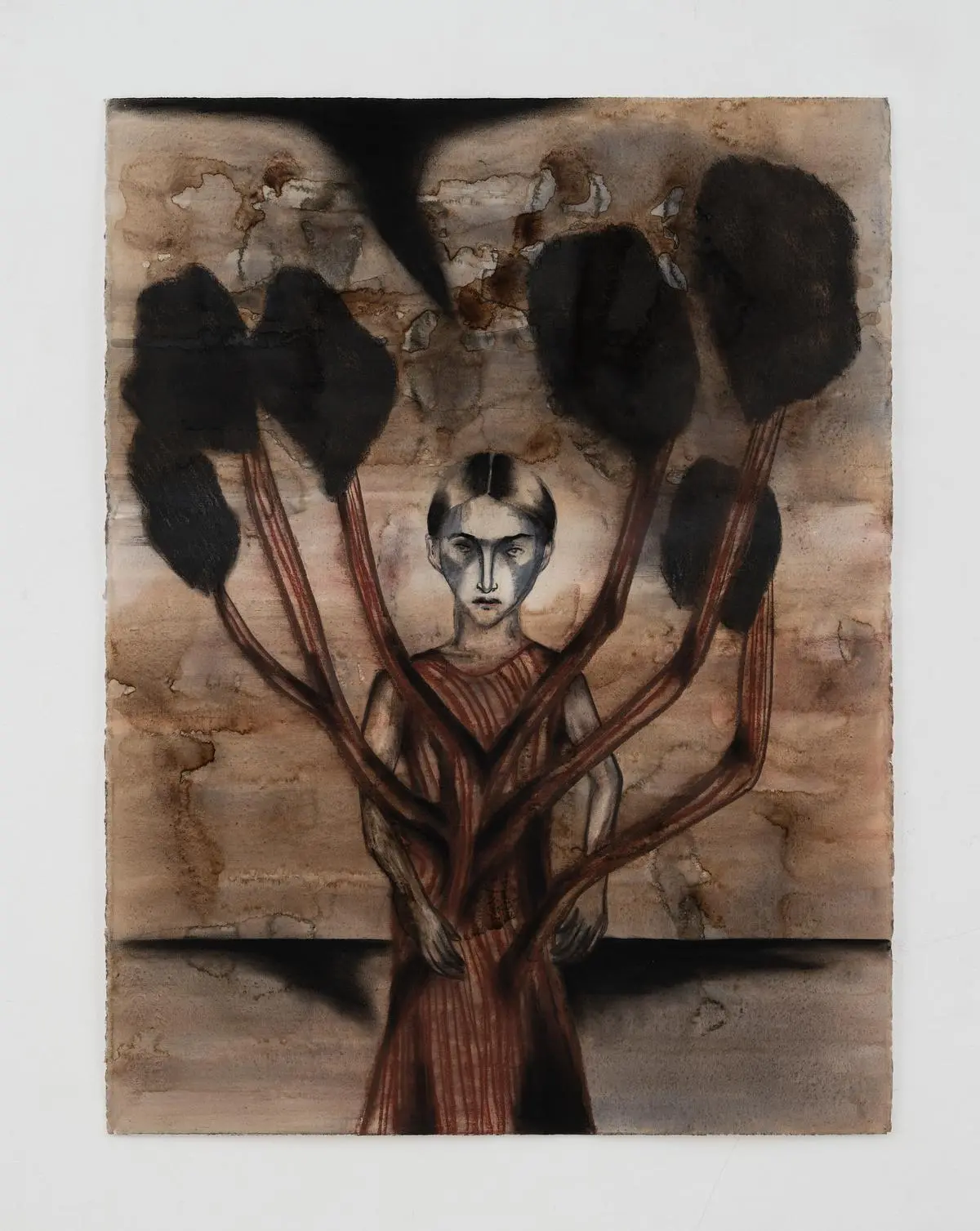
Daphne Centred by Anju Dodiya, watercolour, charcoal and soft pastel on paper, 2024.
| Photo Credit:
Gieve Patel and Vadehra Art Gallery
Most importantly, Padamsee taught Patel how to see. What began as a practice of copying—first Western models and then Padamsee’s art—soon evolved into a unique, intuitive body of work. Patel’s art, like his poetry and plays, delves into humanity’s complex relationship with nature, dramatising the body, death, and decay. Patel painted Mumbai several times. One of these paintings, Early Morning Local (1980), depicts a scene in a relatively less crowded compartment of the local train. A man is dozing off, his mouth open. Two bare feet are placed on the opposite seat. Those who commute by the crowded Mumbai trains know what a luxury it is to be able to put one’s feet up on a seat. There is also a girl sweeping the floor and a group of men standing by the door. Patel portrays his subjects in soft, pastel colours, focussing on intimate interactions and emotional moments.
For the show, Hoskote picked artists who had been Patel’s close friends and lifelong interlocutors—younger artists whose work Patel had been deeply interested in, and on whom he wrote or lectured—as well as those who may have not known Patel closely but are inspired by him. Among the latter is Areez Katki, whose Daphne (After Gieve Patel), based on the Greek myth of the nymph Daphne transforming into a tree to escape Apollo’s unwanted advances, is a tribute to Patel, who too engaged with the theme. The focus of the work—cotton embroidery on dhurrie rug—is melancholy, which overhangs Patel’s work.
Re-engaging with Daphne
Patel’s friend and mentee Anju Dodiya’s Daphne Centred (2024) also goes back to the myth, which Patel had depicted in his sculptures. The moment flesh becomes tree was the subject of his 2007 exhibition titled “Eklavya-Daphne”. Dodiya’s watercolour, charcoal, and soft pastel on paper shows Daphne in the theatre of her heroism.
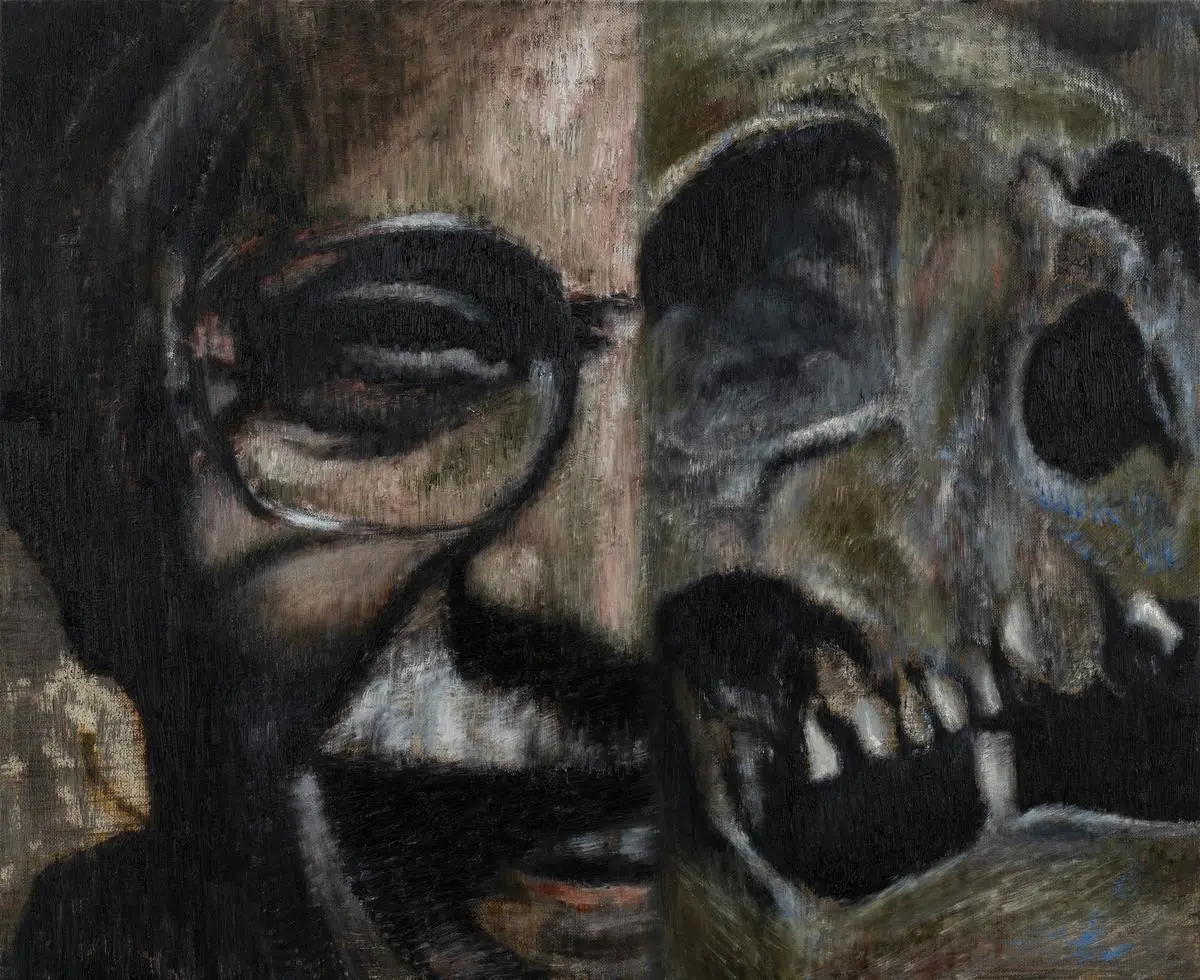
Laughter by Atul Dodiya, oil on canvas, 2024.
| Photo Credit:
Gieve Patel and Vadehra Art Gallery
Sudhir Patwardhan’s Marine Drive shows both the artists engaged in a deep conversation at Mumbai’s seafront. “It is a reflection on long years of friendship between the two,” said Hoskote. Then there is a selection of portraits from Sujith S.N.’s gallery of heads—some fierce, some pensive, others whimsical—which, for Hoskote, resonate with Patel’s long-running “Gallery of Man” series. He painted the series in the 1980s and the 1990s, showing the vulnerability and resilience of ordinary people.
Atul Dodiya’s portraits of Nayanar saints echoes Patel’s own long-standing interest in the spiritual life of quest, doubt, faith, and ecstasy. Another striking work by Dodiya is Laughter. Divided vertically down the middle into two halves, the left is a portrait of Patel laughing, while the right is a skull, its mouth open. As Hoskote said, the work is both endearing and chilling. “It is a memento mori [a Latin phrase meaning: Remember you must die], at a deep level, in the traditional genre of images that remind us of mortality and the evanescence of life. And yet, it also speaks to the power of vitality, its ability to endure as a legacy of achieved work, as affectionate memory,” he added.
Delicious incongruity
The central work of the show is Patel’s painting Peacock at Nariman Point (2000), also from Mumbai. A man holds up a peacock against what Hoskote described as the “severe geometry of a corporate office”. It draws from a photograph by Hoshi Jal, published in The Times of India, of a peacock that had strayed from Malabar Hill to Nariman Point, Mumbai’s business and government hub. The image gave Patel the opportunity to paint, in Hoskote’s words, that “delicious incongruity—a legendary creature framed against the skyscrapers and tower-blocks of the south Bombay skyline”.
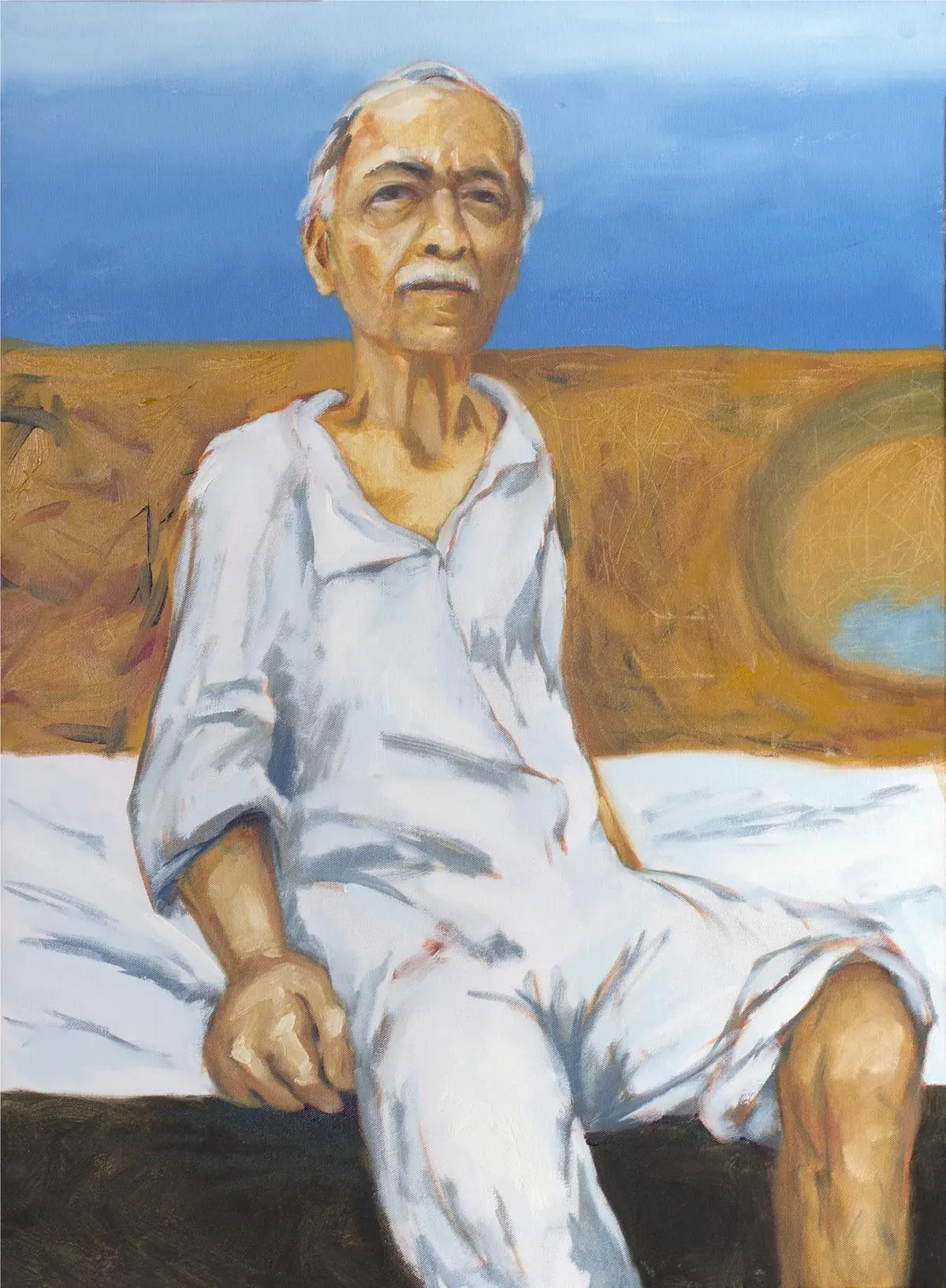
Gieve by Sudhir Patwardhan, oil on canvas, 2023.
| Photo Credit:
Gieve Patel and Vadehra Art Gallery
Without the newspaper report to moor it to a specific context, the photograph becomes intriguing, inexplicable, in which Patel works out the relation between a man and a bird. “The frame becomes incandescent with the sense of restrained energy, as though a resplendent spirit were attempting to leap out from an earth-anchored body,” said Hoskote.
Hoskote further analysed the work saying that the man holding the bird suggests the body holding on to the soul; the bird, poised for flight yet occupying colourful space and exerting its presence, suggests a transcendental dimension of existence, which illuminates our everyday reality with surprise and epiphany.
Also Read | Ways of unseeing: The art of overanalysing art
Patel’s observation of life, the human body, and the city of Mumbai makes the viewer look at these subjects anew. They make us think of our role in making the body or the city what it is. That is Patel’s legacy.
Riddhi Doshi is an independent art, culture, lifestyle, and travel writer based in Mumbai.
Source:https://frontline.thehindu.com/arts-and-culture/gieve-patel-mumbai-art-exhibition-2025/article69481522.ece

